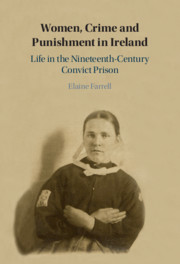Book contents
- Women, Crime and Punishment in Ireland
- Women, Crime and Punishment in Ireland
- Copyright page
- Dedication
- Contents
- Figures, Maps and Tables
- Acknowledgements
- Abbreviations
- Introduction: ‘Another generation of jail-birds’
- Case Study 1 ‘The terrible temptation’
- Case Study 2 ‘A gang of coiners’
- 2 ‘A strange medley of character do these prisoners’ friends present’
- Case Study 3 ‘The workhouse girls’
- Case Study 4 ‘A person of very superior attainments’
- Case Study 5 ‘A most remote part of the country’
- Bibliography
- Index
2 - ‘A strange medley of character do these prisoners’ friends present’
Family Ties
from Case Study 2 - ‘A gang of coiners’
Published online by Cambridge University Press: 21 September 2020
- Women, Crime and Punishment in Ireland
- Women, Crime and Punishment in Ireland
- Copyright page
- Dedication
- Contents
- Figures, Maps and Tables
- Acknowledgements
- Abbreviations
- Introduction: ‘Another generation of jail-birds’
- Case Study 1 ‘The terrible temptation’
- Case Study 2 ‘A gang of coiners’
- 2 ‘A strange medley of character do these prisoners’ friends present’
- Case Study 3 ‘The workhouse girls’
- Case Study 4 ‘A person of very superior attainments’
- Case Study 5 ‘A most remote part of the country’
- Bibliography
- Index
Summary
Chapter 2 draws heavily on surviving letters between inmates and their loved ones, listed addresses in prisoners’ files and visitor records in order to explore the impact of separation and ways families attempted to sustain bonds across lengthy prison sentences. Through four distinct sections, it offers a fascinating insight into family relationships, domestic arrangements, expected responsibilities and obligations. The first section examines the ways imprisoned women sought to maintain contact with their loved ones and vice versa through letter writing. The second section focuses on visitors received by inmates, revealing desires and obligations within the family unit. The third section examines convict mothers’ relationships with their children, some of whom were born in prison and others of whom accompanied their mothers to penal servitude. Changes to legislation and practices across the century restricted convict mothers’ time with their offspring and, towards the end of the century, meant that women with children had to find alternative means to fulfil mothering roles. The final section considers the influence relatives and friends could have on a convict’s release. While it is apparent that family relationships could be maintained, this chapter also shows evidence of strained relationships between incarcerated women and their families and friends.
Keywords
- Type
- Chapter
- Information
- Women, Crime and Punishment in IrelandLife in the Nineteenth-Century Convict Prison, pp. 93 - 128Publisher: Cambridge University PressPrint publication year: 2020

